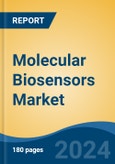Electrochemical is the fastest growing segment, North America is the largest regional market
Speak directly to the analyst to clarify any post sales queries you may have.
10% Free customizationThis report comes with 10% free customization, enabling you to add data that meets your specific business needs.
Key Market Drivers
The global molecular biosensors market is significantly influenced by the increasing demand for rapid and accurate diagnostics. The persistent burden of infectious and chronic diseases necessitates highly sensitive and specific tools for early detection and effective management, particularly as healthcare systems worldwide grapple with widespread health challenges.For instance, according to the World Health Organization's Global Tuberculosis Report 2024, approximately 8.2 million people were newly diagnosed with tuberculosis in 2023, marking the highest number of TB cases recorded by the organization since 1995 and underscoring the critical need for advanced diagnostic capabilities to address such prevalent infectious diseases. This escalating demand drives innovation in biosensor technologies, particularly for point-of-care applications that offer quick results outside traditional laboratory settings, thereby improving patient outcomes and public health responses.
Key Market Challenges
The high initial investment required for advanced biosensor technologies represents a substantial impediment to the growth of the Global Molecular Biosensors Market. Developing these sophisticated devices demands significant capital for research and development, procurement of specialized manufacturing equipment, and establishing the necessary infrastructure for production and quality control. This financial barrier limits the participation of smaller innovative companies and startups, which often struggle to secure the substantial funding needed to bring novel biosensor products to market. It also restricts the pace of adoption in healthcare settings, particularly in price-sensitive markets or for smaller clinics that cannot absorb high upfront costs.Key Market Trends
Increased integration of artificial intelligence and data analytics is profoundly influencing the molecular biosensors market by enhancing device intelligence and diagnostic precision. AI algorithms enable sophisticated data interpretation, identifying subtle patterns and biomarkers that improve the accuracy and predictive capabilities of biosensors, particularly in complex biological environments. This trend moves beyond simple detection to offer more comprehensive insights.According to AdvaMed, an advanced medical technology association, over 1,000 AI-enabled medical devices had received FDA authorization by April 2025, demonstrating substantial adoption and regulatory acceptance of AI in the medical technology sector. Companies are actively leveraging these capabilities; for instance, Thermo Fisher Scientific partnered with BenchSci in September 2025 to develop AI-powered tools aimed at accelerating experimental design and improving research and development productivity in life sciences. This integration is crucial for processing the vast amounts of data generated by modern biosensors, leading to faster and more reliable analytical results.
Key Market Players Profiled:
- Abbott Laboratories Inc.
- Dynamic Biosensors GmbH
- Bio-Rad Laboratories Inc
- F. Hoffmann La Roche
- LifeSensors Inc.
- Medtronic Inc.
- Nova biomedical Corporation
- Siemens Healthcare
- Sysmex Corporation
- Molecular Devices Corp.
Report Scope:
In this report, the Global Molecular Biosensors Market has been segmented into the following categories:By Technology:
- Electrochemical Biosensors
- Optical Biosensors
- Thermal Biosensors
- Piezoelectric Biosensors
By Application:
- Medical Diagnostics
- Food and Beverages
- Environment Safety
- Defense and Security
- Others
By Region:
- North America
- Asia-Pacific
- Europe
- South America
- Middle East & Africa
Competitive Landscape
Company Profiles: Detailed analysis of the major companies present in the Global Molecular Biosensors Market .Available Customizations:
With the given market data, the publisher offers customizations according to a company's specific needs. The following customization options are available for the report.Company Information
- Detailed analysis and profiling of additional market players (up to five).
This product will be delivered within 1-3 business days.
Table of Contents
Companies Mentioned
The companies profiled in this Molecular Biosensors market report include:- Abbott Laboratories Inc.
- Dynamic Biosensors GmbH
- Bio-Rad Laboratories Inc
- F. Hoffmann La Roche
- LifeSensors Inc.
- Medtronic Inc.
- Nova biomedical Corporation
- Siemens Healthcare
- Sysmex Corporation
- Molecular Devices Corp.
Table Information
| Report Attribute | Details |
|---|---|
| No. of Pages | 180 |
| Published | November 2025 |
| Forecast Period | 2024 - 2030 |
| Estimated Market Value ( USD | $ 19.09 Billion |
| Forecasted Market Value ( USD | $ 28.5 Billion |
| Compound Annual Growth Rate | 6.9% |
| Regions Covered | Global |
| No. of Companies Mentioned | 11 |









